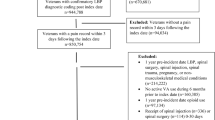Abstract
Background
Narcotic consumption in the workers’ compensation population contributes to prolonged case duration, worse clinical outcomes, and opioid dependence. In 2016, the CDC provided recommendations guiding clinicians on prescribing opioids to adult patients with chronic pain. The objective of our study was to evaluate a cause-and-effect relationship between narcotic consumption and worker compensation claim length before and following guideline revision.
Methods
An administration database was retrospectively queried to identify patients evaluated for spine-related workers’ compensation claimants from 2011 to 2021. Data was recorded for age, sex, BMI, case length, narcotic usage, and injury location. Cases were grouped together by exam date before (2011–2016) and after (2017–2021) the 2016 CDC opioid guideline revision.
Results
Six hundred twenty-five patients were evaluated. Males composed 58% of the study population. From 2011 to 2016, narcotic consumption was reported in 54% of subjects versus no narcotic consumption in 46% of subjects (135 cases). From 2017 to 2021, narcotic consumption decreased to 37% (P = 0.00298). Prior to the guideline revision, mean case length was 635 days. Following CDC guideline revision, there was a significant decline in mean case length duration to 438 days (31% reduction) (P = 0.000868).
Conclusion
This study demonstrates that following revised opioid prescription recommendations by the CDC in 2016, there was a statistically significant decline in opioid consumption and workers’ compensation case length duration. Opioid use may influence prolonged worker disability and delayed return to work.







Similar content being viewed by others
Abbreviations
- BMI:
-
Body mass index
- SD:
-
Standard deviations
- MCID:
-
Minimum clinically important difference
- CDC:
-
Center for Disease Control
- NSAID:
-
Non-steroidal anti-inflammatory drugs
- LBP:
-
Low back pain
- BMI:
-
Body mass index
- RTW:
-
Return to work
References
Anderson JT, Haas AR, Percy R, Woods ST, Ahn UM, Ahn NU (2015) Clinical depression is a strong predictor of poor lumbar fusion outcomes among workers’ compensation subjects. Spine (Phila Pa 1976) 40(10):748–756. https://doi.org/10.1097/BRS.0000000000000863
Berecki-Gisolf J, Collie A, McClure RJ (2014) Prescription opioids for occupational injury: results from workers’ compensation claims records. Pain Med 15(9):1549–1557. https://doi.org/10.1111/pme.12421
Cha EDK, Lynch CP, Jadczak CN, Mohan S, Geoghegan CE, Singh K (2022) Differences in clinically important physical function improvement in workers’ compensation population. Int J Spine Surg 16(1):176–185. https://doi.org/10.14444/8186
Dembe A, Wickizer T, Sieck C, Partridge J, Balchick R (2012) Opioid use and dosing in the workers’ compensation setting. A comparative review and new data from Ohio. Am J Ind Med 55(4):313–324. https://doi.org/10.1002/ajim.21021
Dowell D, Haegerich TM, Chou R (2016) CDC guideline for prescribing opioids for chronic pain--United States, 2016. JAMA 315(15):1624–1645. https://doi.org/10.1001/jama.2016.1464
Dowell D, Haegerich TM, Chou R. CDC guideline for prescribing opioids for chronic pain - United States, 2016 [published correction appears in MMWR Recomm Rep. 2016;65(11):295]. MMWR Recomm Rep. 2016;65(1):1-49. Published 2016 Mar 18. https://doi.org/10.15585/mmwr.rr6501e1
Faour M, Anderson JT, Haas AR et al (2017) Prolonged preoperative opioid therapy associated with poor return to work rates after single-level cervical fusion for radiculopathy for patients receiving workers’ compensation benefits. Spine (Phila Pa 1976) 42(2):E104–E110. https://doi.org/10.1097/BRS.0000000000001715
Franklin GM, Stover BD, Turner JA, Fulton-Kehoe D (2008) Wickizer TM; Disability Risk Identification Study Cohort. Early opioid prescription and subsequent disability among workers with back injuries: the Disability Risk Identification Study Cohort. Spine (Phila Pa 1976) 33(2):199–204. https://doi.org/10.1097/BRS.0b013e318160455c
Ibrahim AR, Elgamal ME, Moursi MO et al (2022) The association between early opioids prescribing and the length of disability in acute lower back pain: a systematic review and narrative synthesis. Int J Environ Res Public Health 19(19):12114. Published 2022 Sep 25. https://doi.org/10.3390/ijerph191912114
Karamian BA, Mangan J, Siegel N et al (2022) Workers’ compensation status and outcomes following lumbar surgery. World Neurosurg 161:e730–e739. https://doi.org/10.1016/j.wneu.2022.02.090
Lavin RA, Tao XG, Yuspeh L, Kalia N, Bernacki EJ (2016) Relationship between opioid prescribing patterns and claim duration and cost. J Occup Environ Med 58(3):e90–e93. https://doi.org/10.1097/JOM.0000000000000625
Mai J, Franklin G, Tauben D (2015) Guideline for prescribing opioids to treat pain in injured workers. Phys Med Rehabil Clin N Am 26(3):453–465. https://doi.org/10.1016/j.pmr.2015.04.005
O'Donnell JA, Anderson JT, Haas AR et al (2018) Preoperative opioid use is a predictor of poor return to work in workers’ compensation patients after lumbar diskectomy. Spine (Phila Pa 1976). 43(8):594–602. https://doi.org/10.1097/BRS.0000000000002385
O'Hara NN, Pollak AN, Welsh CJ et al (2018) Factors associated with persistent opioid use among injured workers’ compensation claimants. JAMA Netw Open 1(6):e184050. Published 2018 Oct 5. https://doi.org/10.1001/jamanetworkopen.2018.4050
Tye EY, Anderson JT, Faour M et al (2017) Prolonged preoperative opioid therapy in patients with degenerative lumbar stenosis in a workers’ compensation setting. Spine (Phila Pa 1976). 42(19):E1140–E1146. https://doi.org/10.1097/BRS.0000000000002112
Webster BS, Verma SK, Gatchel RJ (2007) Relationship between early opioid prescribing for acute occupational low back pain and disability duration, medical costs, subsequent surgery and late opioid use. Spine (Phila Pa 1976) 32(19):2127–2132. https://doi.org/10.1097/BRS.0b013e318145a731s
Author information
Authors and Affiliations
Contributions
Anthony Alvarado: helped with editing/proofreading/writing. Ethan Chang: helped with editing/proofreading/writing. Harel Deutsch: helped with editing/proofreading/writing.
Corresponding author
Ethics declarations
Ethics approval
This article does not contain any studies with human participants or animals performed by any of the authors. This study was supported by the Neurosurgery Research & Education Foundation (2023-24) Clinical Fellowship Grant.
Conflict of interest
The authors declare no competing interests.
Additional information
Publisher’s note
Springer Nature remains neutral with regard to jurisdictional claims in published maps and institutional affiliations.
Rights and permissions
Springer Nature or its licensor (e.g. a society or other partner) holds exclusive rights to this article under a publishing agreement with the author(s) or other rightsholder(s); author self-archiving of the accepted manuscript version of this article is solely governed by the terms of such publishing agreement and applicable law.
About this article
Cite this article
Alvarado, A.M., Chung, E. & Deutsch, H. Effects of the 2016 CDC opioid prescription guidelines on opioid use and worker compensation case length in patients with back pain. Acta Neurochir 165, 2139–2144 (2023). https://doi.org/10.1007/s00701-023-05694-4
Received:
Accepted:
Published:
Issue Date:
DOI: https://doi.org/10.1007/s00701-023-05694-4




